10-13-2018, 06:08 AM
Stan I get that the way to mill that piece of plate would be to pass it across the cutter in the X axis but it was a test piece for a cut that I cannot do in that way. I need to mill a flat surface on the side of the mill overarm in order to fix a cheek plate to each side of the overarm, there will then be a frontal piece bolted and dowelled to the front edge of those cheek plates, to which the j-head will be mounted. A few more photos to illustrate.
This is where I need a flat face, parallel to the long axis of the overarm. In this photo you can see where I have made an attempt to machine this face, the surface is stepped between the two passes of the cutter as described and demonstrated above.
![Filename: IMAG1753[1].jpg
Size: 103.91 KB
10-13-2018, 05:28 AM](attachment.php?thumbnail=15911)
I need a nice flat face here on each side to affix a cheek plate, this photo sort of shows where that will be attached
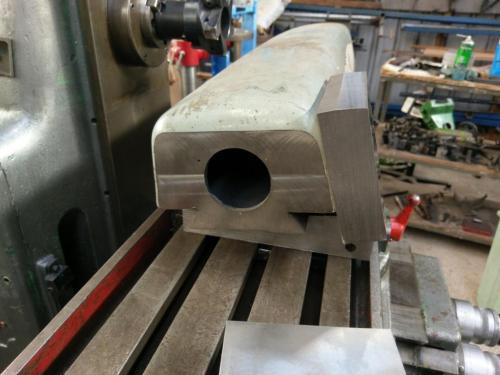
There will be one of these plates on each side; the top of the plates will be milled flat and a third plate bolted down to the top of the two cheek plates and the top of the overarm. The front surface of these three plates will then be milled to a flat plane to which the adaptor plate will be fixed.
The overarm casting is 35" long and weighs 47kg or 103lb. It's shaped like a massive bar of soap and is just as easy to hold onto.
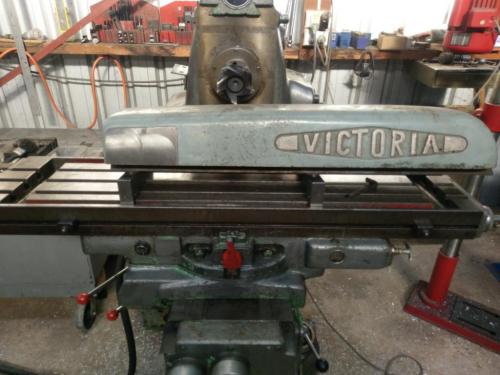

Because the rear edge of the cut is below the surface of the casting, I need to run the cutter along that edge, which is what necessitates making the cut in the Z axis. I am 100% open to suggestions as to how else I might attack this; you know me well enough to know that is a genuine statement and not a smartarse comment. I can't see how I can secure the thing standing on end, I have a 12" x 12" angle plate that usually looks big but not big enough to stand this thing up and take the cuts in X.
Seeing that I had already busted a gut lifting that thing onto the table for these photos, I thought I may as well go ahead and try a cut. Clamping the sucker down is interesting
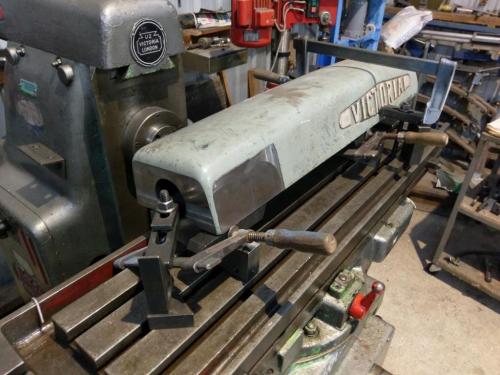
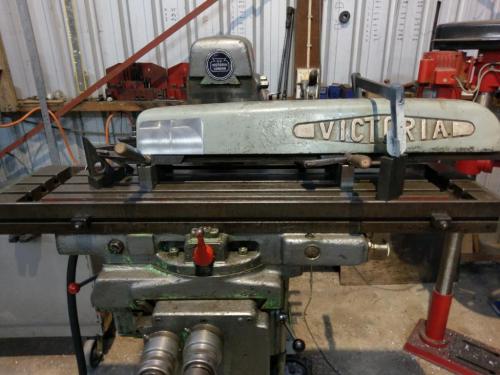
I took a .010" cut, firstly by moving the knee upwards with the cutter at the rear part of the cut. I then went the long way around to bring the cutter above the work for the second pass, again moving the knee upwards. As it happened, I wasn't able to raise the knee high enough to take the face mill fully off the cut at the bottom of the piece so it was still cutting as I moved it across the bottom edge. This photo shows the finished result. The surface does not have a pretty finish but more importantly THERE'S NO STEP!
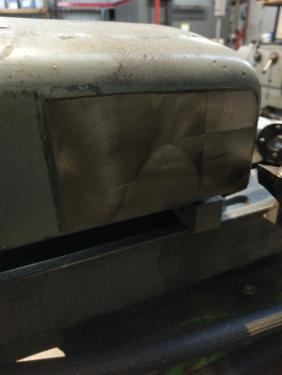
I couldn't give a toss about the appearance of the finish as it will be completely and permanently concealed behind the cheek plate, probably with a little 620 for good measure. Just need it to be flat. Running a finger or a fingernail across this surface, I can not feel where the two cuts meet.
I still have the opposite side to do, like I said I am very receptive to suggestions about how to do this better.
Just as an aside, I have decided that I need to stop whining about stub milling after seeing this guy's videos:
https://www.youtube.com/watch?v=Jpp17Sir0CI
This is where I need a flat face, parallel to the long axis of the overarm. In this photo you can see where I have made an attempt to machine this face, the surface is stepped between the two passes of the cutter as described and demonstrated above.
I need a nice flat face here on each side to affix a cheek plate, this photo sort of shows where that will be attached
There will be one of these plates on each side; the top of the plates will be milled flat and a third plate bolted down to the top of the two cheek plates and the top of the overarm. The front surface of these three plates will then be milled to a flat plane to which the adaptor plate will be fixed.
The overarm casting is 35" long and weighs 47kg or 103lb. It's shaped like a massive bar of soap and is just as easy to hold onto.
Because the rear edge of the cut is below the surface of the casting, I need to run the cutter along that edge, which is what necessitates making the cut in the Z axis. I am 100% open to suggestions as to how else I might attack this; you know me well enough to know that is a genuine statement and not a smartarse comment. I can't see how I can secure the thing standing on end, I have a 12" x 12" angle plate that usually looks big but not big enough to stand this thing up and take the cuts in X.
Seeing that I had already busted a gut lifting that thing onto the table for these photos, I thought I may as well go ahead and try a cut. Clamping the sucker down is interesting
I took a .010" cut, firstly by moving the knee upwards with the cutter at the rear part of the cut. I then went the long way around to bring the cutter above the work for the second pass, again moving the knee upwards. As it happened, I wasn't able to raise the knee high enough to take the face mill fully off the cut at the bottom of the piece so it was still cutting as I moved it across the bottom edge. This photo shows the finished result. The surface does not have a pretty finish but more importantly THERE'S NO STEP!

I couldn't give a toss about the appearance of the finish as it will be completely and permanently concealed behind the cheek plate, probably with a little 620 for good measure. Just need it to be flat. Running a finger or a fingernail across this surface, I can not feel where the two cuts meet.
I still have the opposite side to do, like I said I am very receptive to suggestions about how to do this better.
Just as an aside, I have decided that I need to stop whining about stub milling after seeing this guy's videos:
https://www.youtube.com/watch?v=Jpp17Sir0CI
Lathe (n); a machine tool used in the production of milling machine components.
Milling Machine (n); a machine tool used in the production of lathe components.
Milling Machine (n); a machine tool used in the production of lathe components.




